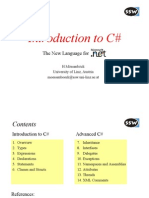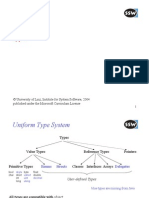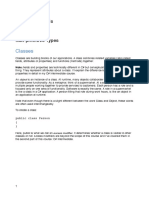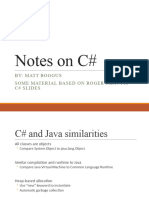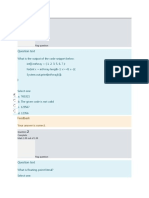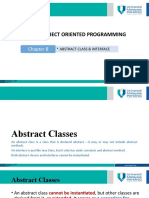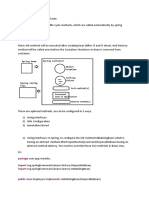4/18/24, 1:15 AM C# in a Nutshell - Code Listings
Chapter 2 - C# Language Basics
A First C# Program
Syntax Basics
Type Basics
Predefined Type Examples
// string, int and bool types are examples of predefined types:
string message = "Hello world";
string upperMessage = message.ToUpper();
Console.WriteLine (upperMessage); // HELLO WORLD
int x = 2015;
message = message + x.ToString();
Console.WriteLine (message); // Hello world2015
bool simpleVar = false;
if (simpleVar)
Console.WriteLine ("This will not print");
int y = 5000;
bool lessThanAMile = y < 5280;
if (lessThanAMile)
Console.WriteLine ("This will print");
Custom Type Examples
// Just as we can build complex functions from simple functions, we can build complex types
// from primitive types. UnitConverter serves a a blueprint for unit conversions:
UnitConverter feetToInchesConverter = new UnitConverter (12);
UnitConverter milesToFeetConverter = new UnitConverter (5280);
Console.WriteLine (feetToInchesConverter.Convert (30)); // 360
Console.WriteLine (feetToInchesConverter.Convert (100)); // 1200
Console.WriteLine (feetToInchesConverter.Convert (milesToFeetConverter.Convert (1))); // 63360
public class UnitConverter
{
int ratio; // Field
public UnitConverter (int unitRatio) { ratio = unitRatio; } // Constructor
public int Convert (int unit) { return unit * ratio; } // Method
}
Instance vs Static Members
// The instance field Name pertains to an instance of a particular Panda,
// whereas Population pertains to the set of all Pandas:
Panda p1 = new Panda ("Pan Dee");
Panda p2 = new Panda ("Pan Dah");
Console.WriteLine (p1.Name); // Pan Dee
Console.WriteLine (p2.Name); // Pan Dah
Console.WriteLine (Panda.Population); // 2
public class Panda
{
public string Name; // Instance field
public static int Population; // Static field
public Panda (string n) // Constructor
{
Name = n; // Assign the instance field
Population = Population + 1; // Increment the static Population field
}
}
https://www.albahari.com/nutshell/E12-CH02.aspx 1/4
�4/18/24, 1:15 AM C# in a Nutshell - Code Listings
Defining a namespace
// The same code, but with Panda defined inside a namespace.
using Animals;
Panda p = new Panda ("Pan Dee");
Console.WriteLine (p.Name);
namespace Animals
{
public class Panda
{
public string Name;
public Panda (string n) // Constructor
{
Name = n; // Assign the instance field
}
}
}
Defining a Main method
// Here's our original program, without using top-level statements.
// (In LINQPad, we set the language in the toolbar above to 'C# Program'.)
using System;
class Program
{
static void Main() // Program entry point
{
int x = 12 * 30;
Console.WriteLine (x);
}
}
Conversions
// Implicit conversions are allowed when the compiler can guarantee they will
// always succeed and no information is lost in conversion:
int x = 12345; // int is a 32-bit integer
long y = x; // Implicit conversion to 64-bit integer
// In other cases, you need explicit conversions:
short z = (short)x; // Explicit conversion to 16-bit integer
x.Dump ("x");
y.Dump ("y");
z.Dump ("z");
Value Types
// The content of a value type variable or constant is simply a value.
// You can define a custom value type with the struct keyword:
Point p1 = new Point();
p1.X = 7;
Point p2 = p1; // Assignment causes copy
Console.WriteLine (p1.X); // 7
Console.WriteLine (p2.X); // 7
p1.X = 9; // Change p1.X
Console.WriteLine (p1.X); // 9
Console.WriteLine (p2.X); // 7
public struct Point { public int X, Y; }
Reference Types
// A reference type has two parts: an object and the reference to that object.
https://www.albahari.com/nutshell/E12-CH02.aspx 2/4
�4/18/24, 1:15 AM C# in a Nutshell - Code Listings
Point p1 = new Point();
p1.X = 7;
Point p2 = p1; // Copies p1 *reference*
Console.WriteLine (p1.X); // 7
Console.WriteLine (p2.X); // 7
p1.X = 9; // Change p1.X
Console.WriteLine (p1.X); // 9
Console.WriteLine (p2.X); // 9
public class Point { public int X, Y; }
Null
// A reference can be assigned the literal null, indicating that the reference points to nothing:
Point p = null;
Console.WriteLine (p == null); // True
// The following line generates a runtime error (a NullReferenceException is thrown):
Console.WriteLine (p.X);
public class Point { public int X, Y; }
Nulls with structs
// A value type cannot ordinarily have a null value:
Point p = null; // This line will not compile.
int x = null; // Illegal, too.
public struct Point { public int X, Y; }
// See "Nullable Types" in Chapter 4 for a workaround.
Storage Overhead
// Structs take up as much room as their fields:
unsafe static void Main()
{
sizeof (Point).Dump(); // 8 bytes
sizeof (A).Dump(); // 16 bytes
}
struct Point
{
int x; // 4 bytes
int y; // 4 bytes
}
// However, the CLR requires that fields are offset within the type at an address
// that’s a multiple of their size:
struct A
{
byte b; // 1 byte
long l; // 8 bytes
}
Numeric Types
Boolean Type and Operators
Strings and Characters
Arrays
Variables and Parameters
Expressions and Operators
Null Operators
https://www.albahari.com/nutshell/E12-CH02.aspx 3/4
�4/18/24, 1:15 AM C# in a Nutshell - Code Listings
Statements
Namespaces
C# 12
in a Nutshell
About the Book
Code Listings
C# 12 in a Nutshell
C# 10 in a Nutshell
C# 9.0 in a Nutshell
C# 8.0 in a Nutshell
C# 7.0 in a Nutshell
Extras
Contact
Buy print or Kindle edition
Buy PDF edition
Read via O'Reilly subscription
https://www.albahari.com/nutshell/E12-CH02.aspx 4/4

























